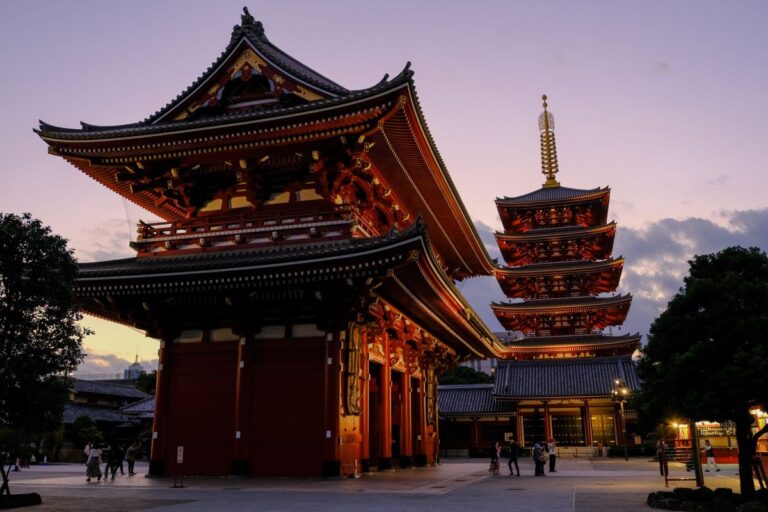Buddhism is one of the major religions in Japan, with a rich history that dates back to the 6th century. It is believed that the religion was introduced to Japan from China and Korea, and has since developed into a unique form of Buddhism that is deeply ingrained in Japanese culture.
One of the most distinctive features of Buddhism in Japan is the integration of Shintoism, the indigenous religion of Japan. This integration has resulted in a syncretic form of Buddhism that is unique to Japan, known as Shinto-Buddhism. This form of Buddhism emphasizes the importance of nature and ancestral worship, and is often practiced in conjunction with Shinto rituals.
History of Buddhism in Japan

Buddhism was introduced to Japan in the 6th century CE, when emissaries from the Korean kingdom of Baekje brought Buddhist scriptures and images to the Japanese court at Nara. Initially, Buddhism was seen as a foreign religion and was met with resistance from the ruling class, who were more interested in promoting the native Shinto religion.
However, over time, Buddhism gained popularity among the common people, and by the 8th century, it had become the dominant religion in Japan. During this period, many temples and monasteries were built, and Buddhist art and architecture flourished.
In the 12th century, a new form of Buddhism called Pure Land Buddhism emerged in Japan. This sect emphasized the importance of devotion to Amida Buddha, who promised to save all beings who called upon his name. Pure Land Buddhism became very popular among the common people, who saw it as a way to attain salvation without having to undergo the rigorous training of the traditional Buddhist path.
Another important development in the history of Buddhism in Japan was the emergence of Zen Buddhism in the 13th century. Zen emphasized the practice of meditation as a means of attaining enlightenment, and it became very popular among the samurai class, who saw it as a way to cultivate mental discipline and focus.
Today, Buddhism remains an important part of Japanese culture and society. While the number of practicing Buddhists has declined in recent years, many temples and shrines continue to attract visitors and tourists from around the world.
Types of Buddhism in Japan

Japan has a rich history of Buddhism, and there are several different types of Buddhism that have been practiced in the country. The following are the most prominent types of Buddhism in Japan:
- Shingon Buddhism: This type of Buddhism is based on the teachings of Kukai, a Japanese monk who traveled to China in the 9th century to study Buddhism. Shingon Buddhism emphasizes the use of mantras, mudras, and visualizations as a way to achieve enlightenment.
- Tendai Buddhism: Tendai Buddhism is based on the teachings of the Chinese monk Zhiyi, who founded the Tiantai school of Buddhism. Tendai Buddhism emphasizes the Lotus Sutra and the idea that all beings have the potential to become enlightened.
- Pure Land Buddhism: Pure Land Buddhism is based on the teachings of the Chinese monk Huiyuan, who founded the Pure Land school of Buddhism. Pure Land Buddhism emphasizes the recitation of the name of Amitabha Buddha as a way to achieve rebirth in the Pure Land, a kind of Buddhist heaven.
- Zen Buddhism: Zen Buddhism is based on the teachings of the Chinese monk Bodhidharma, who is said to have brought Buddhism to China. Zen emphasizes meditation and the idea of direct transmission of enlightenment from teacher to student.
While these are the most prominent types of Buddhism in Japan, there are many other schools and sects of Buddhism that have been practiced in the country throughout its history. Each type of Buddhism has its own unique practices and teachings, but they all share the common goal of achieving enlightenment and ending the cycle of rebirth.
Buddhist Practices in Japan
Buddhism is deeply ingrained in Japanese culture and society, and its practices are an integral part of everyday life for many Japanese people. Here are some of the most common Buddhist practices in Japan:
- Visiting Temples and Shrines: Japanese people frequently visit Buddhist temples and Shinto shrines to pray and make offerings. They may also participate in religious ceremonies and festivals held at these sites.
- Meditation: Meditation is a key practice in Buddhism, and many Japanese people practice meditation regularly. Zen meditation, or zazen, is particularly popular in Japan and is often practiced in Zen temples.
- Chanting: Chanting is another common Buddhist practice in Japan. The most well-known chant is “Nam-myoho-renge-kyo,” which is associated with the Nichiren sect of Buddhism.
- Pilgrimages: Many Japanese people embark on pilgrimages to visit sacred sites associated with Buddhism. The most famous pilgrimage route is the Shikoku Pilgrimage, which consists of 88 temples on the island of Shikoku.
- Offerings: Japanese people often make offerings of food, flowers, and other items at Buddhist temples and shrines. These offerings are meant to show respect and gratitude to the gods and ancestors.
Overall, Buddhism has had a profound impact on Japanese culture and continues to be an important part of daily life for many Japanese people.
Buddhism and Japanese Culture

Buddhism has been an integral part of Japanese culture for over a thousand years. It arrived in Japan from China and Korea in the 6th century and has since played a major role in shaping the country’s art, architecture, and philosophy.
One of the most significant ways in which Buddhism has influenced Japanese culture is through its impact on art. Buddhist art can be found in temples and shrines throughout Japan, with some of the most famous examples being the Great Buddha of Nara and the Kinkaku-ji Temple in Kyoto. These works of art are not only beautiful but also serve as a way for people to connect with the teachings of Buddhism.
Buddhism has also had a profound impact on Japanese architecture. Many temples and shrines were built in the traditional Japanese style, with wooden structures and sloping roofs. The use of natural materials and the incorporation of nature into the design of these buildings is a reflection of the Buddhist belief in the interconnectedness of all things.
Another way in which Buddhism has influenced Japanese culture is through its emphasis on mindfulness and meditation. These practices have become an important part of Japanese daily life, with many people incorporating them into their routines to help reduce stress and improve mental clarity.
Overall, Buddhism has had a significant impact on Japanese culture, shaping the country’s art, architecture, and philosophy. Its influence can be seen in everything from the design of temples and shrines to the daily practices of the Japanese people.
Modern Buddhism in Japan

Modern Buddhism in Japan is a dynamic and evolving tradition that has adapted to the changing needs of society. While traditional temples and practices still exist, there has been a shift towards more contemporary forms of Buddhism that appeal to younger generations.
One example of this is the rise of “urban temples” that are located in bustling city centers and offer meditation classes, yoga sessions, and other activities that cater to urbanites. These temples often have a more relaxed atmosphere and emphasize the practical benefits of Buddhist teachings, such as stress reduction and mindfulness.
Another trend is the incorporation of technology into Buddhist practice. Many temples now offer online meditation classes, and some even have apps that allow users to track their progress and connect with other practitioners.
Despite these changes, traditional Buddhism still holds an important place in Japanese society. Many families still visit their local temple for important life events, such as weddings and funerals, and there is a deep reverence for the country’s ancient Buddhist heritage.
Overall, modern Buddhism in Japan is a diverse and multifaceted tradition that continues to evolve in response to the needs of its practitioners.
The Sum Up
Overall, Buddhism has played a significant role in Japanese culture and history, influencing various aspects of life. It has left a lasting impact on the country’s art, architecture, literature, and philosophy.
Although Buddhism has faced challenges in modern Japan, including declining membership and competition from other religions, it remains an important part of the country’s identity. Many Japanese people continue to practice Buddhism in various forms, from visiting temples to participating in meditation retreats.
As Japan continues to evolve and modernize, it will be interesting to see how Buddhism adapts and changes to meet the needs of contemporary society. However, one thing is certain: the legacy of Buddhism in Japan will continue to be felt for generations to come.




